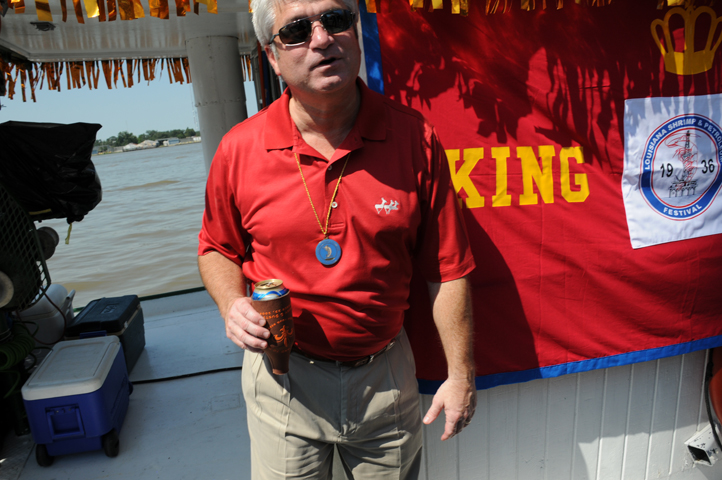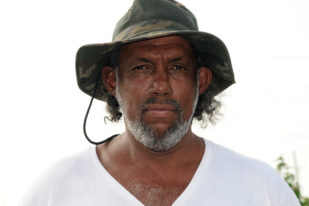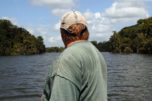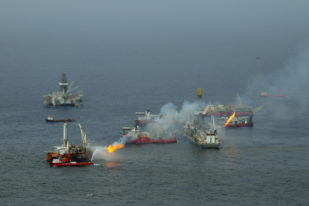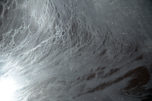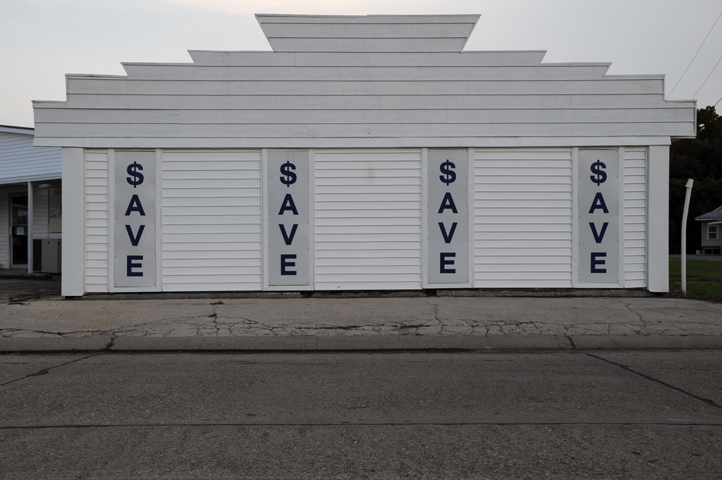For Zoe Strauss
Mattathias Schwartz
It is best to travel on your own account. What I mean is, on your own dime. With Hurricane Sandy (for example) my editor did not want the restaurant that stayed open and the old waitress, a widow, who kept taking the bus to work there each morning. She was sleeping in the basement of her friend’s house on high ground as she tried to figure out what to do with her ruined bungalow. It was still standing, with water stains four feet up each wall. The destruction lacked a sense of completion. Much better was a trailer park perched out on a spit. The storm had smashed it to splintered confetti, something closer to what the apocalypse is supposed to look like. Within the disturbance of such glossy Sunday morning desolation was a comforting message that the epicenter of the disaster had been identified. If the disaster was local enough to have a center, it could probably be contained. The landscape could be repaired, the people compensated, the specific historic roller coaster brought above the waterline and restored. A disaster with such a discrete center can be visited as easily as the Taj Mahal.
I prefer to wander, to make multiple landfalls, fruitless sorties. A good search should be vague, and thorough, and random, and therefore lengthy, possibly quite expensive. Tell yourself that you are searching for something in particular. It doesn’t really matter what. “To be aware of the possibility of the search is to be onto something,” writes Walker Percy. “Not to be onto something is to be in despair.” You will meet the people who were there to begin with. They will have some special knowledge. To access it, you must barter away a piece of yourself. The less you withhold, the less they will withhold. This exchange is what you came for.
Those who would argue that things on the whole are getting better make their case with “development” numbers, measurable improvements in the standard of living, the gross domestic product, life expectancy, infant mortality, access to modern conveniences. To rebut this story, look at whatever isn’t being counted—the number of fish in the ocean, the carbon in the atmosphere, the sonar-addled whales, the dead dolphins washing up on the beach. These numbers are not observed as assiduously as approval ratings or quarterly earnings. Our interest is in the weather tomorrow, not ten years out. But these two lines seem to be intersecting with greater frequency. The second set of numbers ruptures the first, offering a glimpse of a less pleasant future. Standing at the edge of the volcano, the observer is there to conduct, to increase the blast radius, to insulate as little as possible, to come back burnt.
Begin somewhere near home. Zoe Strauss began in Philadelphia, among the residue of fallen industry. Philadelphia is famously haunted by memories of its past. Sometime around 1995, when Terry Gilliam shot 12 Monkeys at City Hall and the Eastern State Penitentiary, it started to look more like the future. In the center are many imposing buildings, some of them abandoned like the Hale Building and the Divine Lorraine Hotel. Somewhat like the U.S. Constitution, they appear to us now as tattered monuments left behind by an alien race. Like Ozymandias, they were too proud to imagine their own extinction. More persistent are the rowhouse neighborhoods, many of them built eighty or one hundred years ago as temporary housing for workers. The politics are clannish and cannibalistic, enmeshed with patronage and inherited networks of personal loyalty. Seniority is key. The oldest birds have the privilege of dipping their beaks wherever they choose. Take the new casinos, vulture-like entities designed to lick the city’s carcass clean.
Strauss circulated her photographs on the underside of Interstate 95 where Washington meets Columbus. Once a year, for ten years running, she posted her work on the freeway’s concrete pillars and sold prints for five dollars each. Much of the work was a record of the city’s human terrain. The corpse of Philadelphia’s industrial past was fetid and quite fertile. Empty space, low rent, cheap drugs, and lack of conventional opportunity conspired to make the place a cornucopia of deviance. Strauss was native to all this. She came to photography relatively late, and casually, having received a camera as a present for her thirtieth birthday. The I-95 work is from the perspective of a pedestrian, an inveterate urban walker. It demonstrated a gift for noticing reminiscent of Robert Frank. Like Frank, Strauss was fundamentally a shy person, but unlike him, she could force herself on these walks into bewitching feats of extroversion. She learned how to make a stranger into a friend, how to do it quickly, and how to do it over and over again. She practiced with airplane seatmates, but practice isn’t the right word, because each time she did it the communion was for real.
Among the phenomena Strauss’ early photographs document is her rapport with subjects, especially at those moments when they lay bare the wounds and ornaments inflicted upon their own skin. I can only imagine that she developed her technique by making herself known as a consistent presence on a regular beat. The I-95 shows were part of that. They blurred the lines between the photographer’s subjects, neighbors, friends, and buyers. They also served as an implied announcement that the material she was gathering was not for export.
I was with Strauss in September 2010 for the Louisiana Shrimp and Petroleum Festival in Morgan City. A few months prior, in April, the Deepwater Horizon offshore rig had exploded, leaving its hole wide open under five thousand feet of water, sending as much as fifty thousand barrels of oil a day pouring into the Gulf of Mexico for eighty-seven days. Like Katrina and Sandy, the oil spill could be traced back to demand for fossil fuels. But the link was far more direct, so direct that there were billions of dollars at stake for the corporations whose employees had caused the spill to happen. This made the spill difficult to document. Only a handful of journalists were allowed to visit the “source,” above Mississippi Canyon Block 252, the place where the oil was actually coming out into the ocean. Others, including Strauss and myself, were afforded a quick look at the site from the back of a plane. Even as BP’s proxies attempted to frame maritime oil emissions as a relatively harmless nuisance, the company was placing whatever hurdles it could between those who had come to observe and those points where the oil touched land. Highways, bridges, and miles of public beach were summarily closed. We were told this was for our own safety, even as buses of temporary workers in gloves and galoshes and fluorescent vests passed through the roadblocks, shoveled the black sand into fifty-gallon bags, and hauled it away.
Despite these constraints, Strauss made her record. She found oil snaking over and around the fragile booms and congealing into fist-sized pies on the sand. Her images capture the extraordinary futility of trying to clean hundreds of miles of coastline. The “cleaning” was staged visual rhetoric—lines of boom floating in the ocean, armies of workers with shovels, a boomlet of money spraying out via contractors, claims offices, T.V. ad buys. Strauss witnessed a range of reactions to the oil, from an older woman recoiling in disgust to a teenage boy paddling around in the slickened water, apparently content. This second image contains a taste of what we saw in Morgan City. The de-wilding of the Louisiana bayou had been underway for many decades, so long that drilling into the seabed to suck out oil was no less “natural” than harvesting shrimp. Up close, the slapstick irony of a Shrimp and Petroleum Festival dissolved. It dissolved a few moments after we got out of our rental car. Strauss crossed a neat green lawn to introduce herself to the festival’s reigning king, Al Adams III, whose endorsement of petroleum was no less sincere for the good money he’d made as an offshore supply man. I wrote down his quote: “Shrimp and petroleum need to coexist peacefully. I don’t think the country realizes that everything from shoes to bicycles comes from the petroleum business.” The man’s apparent decency and belief in our good faith clashed with my unspoken distaste for his views. Strauss bulldozed through this awkward membrane with nods and words of affirmation. Almost immediately, she began taking pictures. This was not deception. She was seeking a genuine exchange.
Days later, on the edge of town, we met Madison Tune, a casual fisherman with many stories of pools of oil that he had seen and sums of money the spill had cost him. He took us out by boat into his fishing grounds, and further out into the shallow channels of the swamp. Deep inside, under the canopy’s emerald light, we saw three moldering foam chairs, the remnants of some school bus or movie theater, now the outdoor living room for a fishing camp. The Gulf of Mexico had already been ruined long ago, and it was wild nature, not oil, that was gathering in hidden pools and oozing up through the cracks.
Capital itself appears in Strauss’ work like Christ in the Spanish New World, a seismic force rendered in quasi-pagan drawings and rituals as tribute to a conquering power. She takes note of a disembodied hand clutching a wad of bills, a child clutching a Benjamin-skinned carnival bear, a middle-aged man seated on high rigging, peeling off singles for the unseen crowd below. Strauss is interested in the folk worship of money. These rituals will seem primitive only to those unwilling to admit their truth. More frightening are capital’s sterile temples: The parking lots; the numbered chambers that could be storage units or windowless motel rooms; the white vinyl-sided ziggurat without windows or doors, just the word “$AVE.” Capital is a seismic force, confronting us with the choice of whether to surf along or to stay put and be reduced to rubble. But the wheel is turning. There are larger and more awesome forces on the horizon. To apprehend such forces and put them into a language we can understand is the work of prophets.

